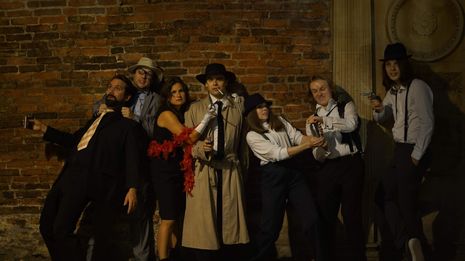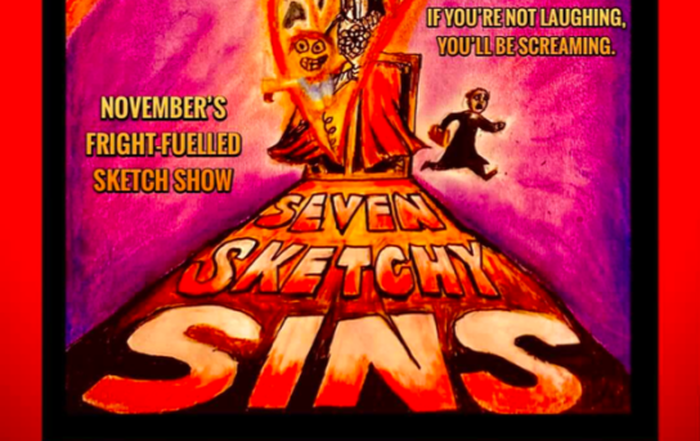Improv Noir is a Killer Production
You don’t have be Sherlock Holmes to detect the comedy gold in this improvised murder mystery

I have to say, I baulked somewhat at telling people that my first Varsity review was set to be for an improv murder mystery. Not, I hasten to add, because I have an issue with either element of this format; I decided to check it out in the first place because I’m a big murder mystery fan. This enjoyment is perhaps what made me sceptical. I was thinking of the tightly plotted nature of a murder mystery, and wondering how that could possibly be achieved in an entirely improvised set-up. However, I was entirely converted, so much so that it was the ways in which the production utilised the nature of the murder mystery where it particularly shone.
I had forgotten, of course, that the classic who-dunnit murder mystery is a genre with a formula, and the production exploited this to great success. The show was framed by Rookie Detective Billy Sullivan (director Mike Bradley), addressing the audience as an even newer detective. Although I’m afraid I inadvertently destroyed the evidence for exactly what the name of this detective was, by writing over it in the dark, its repeated pronunciation in Sullivan’s impressively consistent New York accent never failed to bring a laugh. Sullivan discusses a case investigated by himself and experienced Detective Richard Hardigan (Barney Slater), and allows the audience to fill in the classic Cluedo categories. Rather than the butler in the drawing room with the candlestick, in last night’s mystery ‘Mike the Clown’ (both his full legal name and his occupation) was killed ‘with poison’ at ‘a birthday party’ (despite vocal calls for a Minneapolis, Minnesota-based setting, from audience members I can only assume were natives, or fans, of the city).
"The production utilised the nature of the murder mystery"
The production was at its best when it utilised the elements the genre offered to give the play some definition. A crime scene and a series of police interviews allowed the audience to quickly get to know several characters, culminating in a return to the frame narrative with a suspects line-up - effective in its simplicity. In these moments, lighting by producer Yuhang Xie was particularly well executed, as the simple changes allowed for a clear delineation between storyline and framing. Their decisive operation of lighting was particularly well considered in the latter half of the play, which sometimes suffered from the absence of the more rigid structure of the first, as well timed blackouts curtailed some more directionless scenes. Even these weaker moments were not to the detriment to the play as a whole, with the element of the classic murder mystery denouement allowing Slater and Bradley, as the detectives, to skillfully pull together the threads of the rest of the play into satisfying final monologues.
"The opportunity for a satisfying punchline was rarely missed"
Within this formula, they struck another thing that works with murder mysteries and comedy: understanding what people are expecting. The opportunity for a satisfying punchline was rarely missed. For example, when you pull a drivers’ licence from a clown’s pocket you have to hope someone might note it is in fact for driving a very small car, and it was satisfying to see those beats consistently hit. The format, as well as the intimacy of the Corpus Playroom, pulled the audience into the camaraderie of the cast, with the brilliant creation of fan favourite character ’Mincent ‘Mini’ Soda’ (Tom Sweeney) prompting loud cheers. The performers drew on noir archetypes available to them to establish distinct characteristics quickly and successfully in each character. They struck an unselfconscious balance in their fourth wall breaking, with the awareness of the improvised nature of the performance only enhancing moments such as those in which performers were backed by their grinning costars into corners that required improvised clowning (literal clowning, that is). Nor did they shy away from fulfilling these elements, with a particularly excellent piece of physical theatre between Michelle the Clown (occupation only, and no relation to (but some relations with!) the victim, played by John Conacher) and Detective Sullivan with the pulling of many invisible handkerchiefs from a hat.
"Performers were backed by their grinning costars into corners that required improvised clowning (literal clowning, that is)"
What impressed me most was the creation of a full story from such bare bones, which is an excellent distillation of the murder mystery. After all, there couldn’t be quite so many episodes of Midsomer Murders if we weren’t so willing to embrace the same formula repeated anew. A genre willing to accept death-by-rolling-wheel-of-cheese is surely ready for whatever improv can throw at it.
I found myself, even before the audience decided the murderer of the piece, writing down a clue in my notebook (which, after an hour in the dark, looked more like a killer’s note than a detective’s notebook) as if I too was investigating the crime. There were genuine themes and ideas built into the play, with the actors constantly expanding the ‘world’ and background of the mystery. Adam Page in particular did this masterfully, with his role as the detective’s father feeling so integral to the metaphor the play ended up going for that I had assumed his character was a consistent one across performances until speaking to him afterwards. A friend of mine vehemently criticised the ending that was chosen, criticism that I feel the performers should take as the sincerest of compliments: she had so strongly felt the themes about fatherhood and selfhood established within the play that she was terribly disappointed that these were not resolved in a more positive way in its conclusion.
 News / Eight Cambridge researchers awarded €17m in ERC research grants27 December 2025
News / Eight Cambridge researchers awarded €17m in ERC research grants27 December 2025 News / Downing investigates ‘mysterious’ underground burial vault 29 December 2025
News / Downing investigates ‘mysterious’ underground burial vault 29 December 2025 News / News in Brief: carols, card games, and canine calamities28 December 2025
News / News in Brief: carols, card games, and canine calamities28 December 2025 Sport / Hard work, heartbreak and hope: international gymnast Maddie Marshall’s journey 29 December 2025
Sport / Hard work, heartbreak and hope: international gymnast Maddie Marshall’s journey 29 December 2025 Interviews / Meet Juan Michel, Cambridge’s multilingual musician29 December 2025
Interviews / Meet Juan Michel, Cambridge’s multilingual musician29 December 2025







